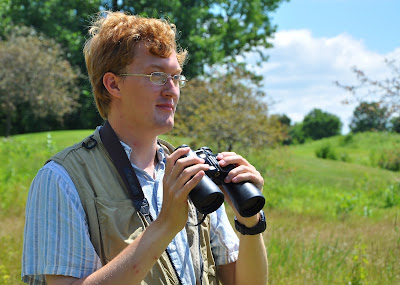 Visiting the seediest
Visiting the seediest place in Lisle
(published 11-8-16)
Does anybody else remember The Nature Company? The retailer
had a store at Oakbrook Center, in the 1990s. It was a fun place to look
around, like a shop you’d find in a natural history museum but on a grander
scale with Disney-like branding and merchandising. Perfect for the mall.
Well, The Nature Company didn’t survive. Maybe the goods
were too pricey, or perhaps the advent of online shopping played a role. Or maybe
the store simply didn’t carry enough bird stuff!
These thoughts entered my head after a recent visit to Wild
Birds Unlimited in Lisle. The franchise on Ogden Avenue is going on 28 years, a
pretty amazing run. I went there to find out more from its original and current
owner, Brian Neiman.
I’d never met Brian and frankly expected him to be older.
And why had we never crossed paths on a bird walk or at a bird club meeting?
Because my assumptions were misguided, that’s why. Neiman is 52 and even though
he caters to birders he is not inclined to go birding. Birds are his business,
not his hobby.
After graduating from Michigan State in 1986 Neiman took a
job with Apple Computer in California. But he quickly realized that corporate
life didn’t suit him and hightailed it back to the Midwest. He wanted to be his
own boss.
 |
|
Wild Birds Unlimited store owner Brian Neiman shows a hopper-style feeder to a customer. |
Lisle was the first, in 1988. The store, initially located in
a shopping strip at Route 53 and Maple Ave., moved to its present location in
1998. All four stores remain open, including one in Arlington Heights, but today
Neiman is involved only with the Lisle outlet.
“I don’t consider myself a ‘birder’ but I do love birds,” he
told me.
He loves being more than bird seed retailer, too. With a reliable
staff and his store on solid footing, Neiman keeps an eye on the bigger picture.
“As owner, I use the business as a platform to get people
educated and engaged in feeding birds, and for making people more aware of how
their backyard landscape choices can affect our local biological diversity.”
Neiman believes in native plants and pesticide-free natural
landscaping. He practices these tenets on his home property in Naperville and
in the garden outside the store.
Customers, though, needn’t fear a lecture when they stop by
for a package of Bark Butter or a bag of No-Mess Blend. The Lisle WBU is casual
and friendly, with helpful advice available for all who visit.
“We’re as likely to have a conversation about ridding your
feeders of ‘blackbirds’ as we are to chat about attracting bats, the best
native shrubs for berries or how to combat carpenter bees at your home.”
The subject of squirrels and their quest for world
domination comes up often, too.
Of course WBU is primarily about the birds, dedicated to those
who love feeding and watching them. It can and must be said: Birders enjoy
hanging out at the seediest place in Lisle. Inside is a candy store for bird
and nature geeks. Outside, well-stocked feeders and birdbaths tempt visitors to
stay and see what comes in. (In 2014 a European goldfinch appeared; Neiman
swears he didn’t “plant” it.)
WBU’s top selling points are seed freshness and product
variety. Customers can keep their bulk seed purchases at the store and pick up supplies
as needed. Try asking a “big box” store for that.
“We don’t sell lumber, motor oil, drywall, chemicals or
paint,” Neiman explained. “We offer products sold by an adult who can answer
any question related to the hobby and who actually cares about your success in
attracting the birds you desire.”
 Seed is No. 1 at WBU but the store also offers a wide choice
of field-tested bird feeders, bird houses and water features. Related
accessories, gift items and gear round out the inventory, including binoculars
from Eagle Optics.
Seed is No. 1 at WBU but the store also offers a wide choice
of field-tested bird feeders, bird houses and water features. Related
accessories, gift items and gear round out the inventory, including binoculars
from Eagle Optics.
Neiman expects 2016 to be his store’s best year ever. He credits
the freshest bird seed and good service for building customer loyalty. The closing
of a Wild Bird Center franchise in Wheaton a few years ago hasn’t hurt WBU’s
business either.
When I asked about challenges, Neiman mentioned competition
but not the kind you might think. In his view, the enemy is those time-sucking electronic
gadgets that increasingly rule our lives.
“People, especially those under the age of 40, are
completely disconnected from nature,” he said, “and I fear we’ll keep drifting
in that direction. Virtual reality is isolating us from the wonder of the
natural world.”
WBU’s loyal shoppers are more connected to nature than most,
even if that connection, for some, exists mainly in their backyards. I think
about the children and the grandchildren of Neiman’s customers as well, because
bird feeding can provide a spark.
Kids who grow up watching birds outside the kitchen window
may or not become birders, but they might acquire a bit of that wonder.
At any age, letting more nature into our lives can only be
good. Studies prove it. So I’m a big fan of stores like WBU that make it easy
to bring birds a little closer.
The Nature Company is long gone, but our community has something better: a thriving, locally owned bird and nature store with real people inside. It’s a fun place to get connected. No gadgets necessary.
Copyright 2016 by Jeff Reiter. All rights reserved.
The Nature Company is long gone, but our community has something better: a thriving, locally owned bird and nature store with real people inside. It’s a fun place to get connected. No gadgets necessary.
















